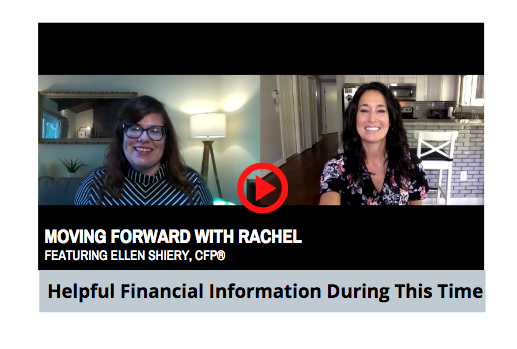Click here to watch now!
Rachel: Hi, everyone! It’s Rachel Frentsos with the Annapolis Fine Homes office of Long & Foster. I hope this video finds you healthy and well. Today is my Moving Forward with Rachel. I am unable to go to the place of business, but I have Ellen Shiery from Merril Lynch* on here with me. Hi, Ellen!
Ellen: Hi!
Rachel: Thanks so much for joining me! I really appreciate it!
Ellen: Thank you so much for having me!
Rachel: Sure! I know I have personally had lots of financial questions during this time, so I thought it would be great to bring her on here to just answer some questions you might have, or even give you some information you haven’t heard about yet.
A lot is being said in the news about the CARES Act. First and foremost, can you explain what that is and what it means?
The CARES Act
Ellen: So, CARES actually stands for something. It’s the Corona-Virus Aid Relief and Economic Security Act, which is a mouthful. It is part of the overall economic stimulus plan that the federal government has put in place to try to prop up the economy while we’re going through this uncertain time.
It has a number of benefits for both individuals and businesses. I want to talk to you a little about some of the individual benefits, because it goes far beyond just the stimulus checks that you might have heard about in the news over the past month or so.
Those stimulus should, for the most part, be out by this time. If you didn’t receive a check, that doesn’t mean that you won’t be eligible for something. It’s actually a 2020 tax benefit, so when you file your 2020 taxes next year in 2021, you might find that your tax bill is a little lower than you expected it to be.
Rachel: That’s great news! Thank you!
Federal Student Loans
Ellen: One of the other items that has received a lot of press is the temporary relief for federal student loan borrowers, which I know is a lot of people. All federal student loan payments, and that includes both principal and interest, have been suspended for six months (through September 30) with no penalty whatsoever. But, it does apply only to federally owned loans.
Rachel: How many loans are federally owned?
Ellen: About 95% of student loan borrowers have federal student loans, so it applies to the vast majority of people.
Retirement Plan Withdraws
There are some provisions that allow for tax-favored withdrawals from retirement plans. You can withdraw up to $100,000 from an IRA without an early withdrawal penalty of 10% that would normally apply if you’re over 59 1/2 , but the withdrawal does have to be for a coronavirus-related item.
Rachel: What does that mean? What is considered coronavirus-related?
Ellen: It means that you are considered to have a purpose for withdrawal if you, your spouse, or a dependent has been diagnosed with CODID-19, or if you’re being quarantined, you’ve been furloughed, laid off, have reduced work hours, if you’re unable to work because you don’t have child care, or even if your business has had to close down, or has had reduced hours.
There are a number of problems, but you want to make sure that if you’re making a withdrawal, you have one of those designated reasons so that you will be eligible for that waiver of the 10% penalty.
Retirement Plan Loans
Related to that, you can also take a loan from a qualified retirement plan, which would be a 401K, a 403B, something that’s an employer-sponsored plan. The loan amount has been increased from $50,000 to $100,000, but no more than the balance of a plan. Some payments have been waived for those accounts as well.
Rachel: That’s great! So, if someone has, or is considering, a 401K loan what should they do?
Ellen: The first thing they should do is contact their HR representative to make sure that their plan has adopted those provisions, and discuss that with them.
As a financial planner, I would urge anyone considering taking either a 401K loan or a retirement plan distribution to talk to a financial professional first to make sure they have exhausted all other options before doing that.
Required Minimum Deductions
Related to that, for folks who are over 70 ½ and have been taking their required minimum distributions, this next item that we’re going to talk about is something that they should discuss with a financial professional as well, because the CARES Act has waived the required minimum distribution provision for 2020.
For those who have been taking RMD’s, they don’t have to take an RMD this year. For those who turn 70 ½ in 2019, and who deferred their first RMD to April 1st of 2020, I know this is a little complicated. If you turned 70 ½ in 2019, and you didn’t take your RMD, now do you not only not have to take it for this year, you don’t have to take it next year as well.
It’s a benefit for those who are not necessarily needing it back for income. It gives them the opportunity to reduce their tax liability for 2020. And, also to leave funds in their accounts to give it the opportunity to rebound from the market pull-back that we’ve seen.
Rachel: Oh, good! Now, what if somebody already withdrew their RMD?
Ellen: That’s even better news. The CARES Act actually has a provision to allow someone who has already taken their RMD to roll that back into the plan and have it not be considered a distribution.
Right now, that’s still a 60-day window; however, back in 2008-2009, the IRS had released guidelines that allowed that to be extended. It’s reasonable to assume that will happen again this year. So, if you’ve already taken your RMD and you don’t need those funds, get in touch with your financial professional as quickly as possible.
Rachel: Good! That’s great advice! Just moving on, what about charitable contributions? Any changes to that?
Charitable Contributions
Ellen: Of course, Rachel, you and I know each other because we both sit on the Board of Anne Arundel County CASA. We’re court-appointed special advocates for kids in foster care. This last provision is something that’s really important for nonprofits.
First of all, starting in 2020, for those who do not itemize your deductions, you’ll be able to take what’s called an “Above the Line” deduction of $300 for a charitable contribution. It does need to be in cash.
The other big provision that changed is folks would normally be capped at how much of their adjusted gross income could be considered a charitable contribution. For 2020, 100% of someone’s income can be donated to a charity and receive that contribution deduction.
There are some complicating factors, so it’s something that someone would really need to have a discussion with their tax preparer to make sure that they are doing everything they need to do to qualify for it.
Rachel: Am I understanding you correctly? This year you can write off more charitable contributions. Is that what you’re saying?
Ellen: Right! There’s opportunity for you to make larger contributions and to have more of them considered contributions for tax purposes.
Rachel: Well, Ellen, this has been incredibly helpful. I know I learned a lot today and we talk all the time! I really appreciate it!
If any of you have any questions, we will put Ellen’s information in this video so you can reach out to her directly.
It is a great time to get with your financial planner, and if you need one, Ellen is fantastic!
Thank you, again, and I hope to see you very soon! Hopefully, we’ll get the CASA Gala rolling this year.
Ellen: I hope so! Looking forward to it!
Rachel: Thanks, Ellen! I’ll see you soon!
Ellen: Thank you!
Bye!









